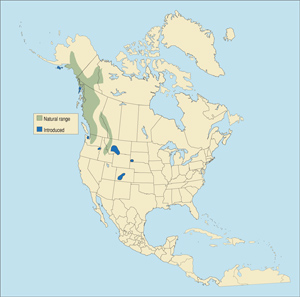 |
Oreamnos americanus
Cabra de las Rocosas (Sp), Schneeziege (G), Chèvre des Montagnes Rocheuses (F). Also called Rocky Mountain goat, a poor name because the bulk of its population is found west of the Rocky Mountains. The name "mountain goat" is also misleading because, biologically, it is not a true goat; it is a member of the Rupicaprini tribe-the goat-antelopes-whose members are more primitive than true goats. They include the chamois of Europe and the Middle East, and the serows and gorals of Asia. Scientists believe the American mountain goat originated in Asia and migrated to North America over the Bering land bridge about 600,000 years ago.
DESCRIPTION (male) Shoulder height 35-40 inches (90-100 cm). Weight 150-300 pounds (70-135 kg). Females are about 15 percent smaller than males.
A medium-sized animal with a short, slab-sided body, humped shoulders and a long, narrow head. The shaggy coat is white or yellowish-white (vanilla) in color, with long underwool, and longer guard hairs that form a stiff mane on the neck and rump, and pantaloons on the thighs. Both sexes have a beard. The legs are long and heavy, and the large hoofs have rubbery pads in the center for sure footing on rock. Black scent glands are located behind the horns in both sexes. Both males and females grow short, sharp, black horns. The horns of the female are slimmer, straighter, and less divergent at the tips than those of the male, and can be longer as well.
BEHAVIOR Social structure is variable, and zoologists differ as to whether males or females are dominant. The sexes seem indifferent to each other except when mating. Nannies and kids are commonly found in herds; billies are solitary or in small bachelor groups. As the mating season approaches, males dig rutting pits that become soaked with urine, and their sides and bellies become stained by the wet soil. Older males can be identified at a considerable distance during the rut by their soiled appearance. Males fight each other for dominance and mating prerogatives. They do not fight head-to-head, which is a good thing because of their thin facial skin and weak skull; instead they stand head-to-rump and strike with their sharp horns against each others' belly and haunches, often with fatal results. The skin is thickest in the rump area-as much as seven-eighths of an inch (22 cm)-but this is not always enough protection. Nannies use their horns to acquire and defend their social position among other females. Mating occurs from November to January, with births in May and June. A single kid is the norm, but twins are common and triplets occasional. The kids stay with their mother until she drives them away when she again gives birth. Maximum life span in the wild is 14 years for males, somewhat longer for females.
The mountain goat is an extremely tough, durable animal. The most sure-footed mountaineer of any New World ungulate, it is renowned for its ability to climb and jump in precipitous terrain. Rarely in a hurry, it moves deliberately even when alarmed or threatened, however, can run rather well if necessary. Swims well, being able to cross large lakes. Active early and late in the day, frequently feeding through the night. Both a grazer and a browser, feeding on grasses, mosses, lichens, herbs, and supplementing with woody plants. Beds in shallow depressions excavated with its feet. Eyesight is extremely keen, able to detect far-off movement. Hearing and sense of smell are adequate, but are not relied on to the same extent.
HABITAT Steep slopes, cliffs and glacier edges in alpine areas that have low temperatures and heavy snowfall. Sometimes in nearby meadows and valleys.
DISTRIBUTION The high mountain ranges of northwestern North America, from southern Alaska southward through the Coast Mountains of British Columbia to the Cascades of Washington, and in the Rockies of British Columbia, Alberta, Montana, Idaho and Utah. There are also limited populations in the Yukon, and in the Mackenzie Mountains of the Northwest Territories. Has been introduced on Kodiak, Baranof and Chichagof islands in Alaska; on the Olympic Peninsula in Washington; in northeastern Oregon; in several areas in Montana; in the Black Hills of South Dakota; and in several ranges in Colorado.
REMARKS The mountain goat is a first-rate game animal. Its eyesight is as good as that of a mountain sheep and it occupies far more difficult ground. Most easily stalked from above, because it does not usually anticipate danger from that quarter. A mountain goat makes a spectacular full mount, especially when taken in late season when the hair is long and thick.
Care should be taken not to shoot one in a place where the brittle horns will be broken from a fall-or to shoot one where it cannot be recovered. When hunting in precipitous areas, ropes and other mountaineering gear should be available.
TAXONOMIC NOTES Four subspecies have been named, but their validity is uncertain. We do not separate them.
STATUS Because of its generally inaccessible habitat, the mountain goat has been less affected by people than any other North American big game animal. It has a poor record of survival in zoos.
|




